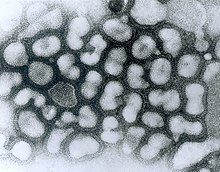Influenza A virus subtype H9N2
| Influenza A virus subtype H9N2 | |
|---|---|

| |
| Influenza A - late passage | |
| Virus classification | |
| (unranked): | Virus |
| Realm: | Riboviria |
| Kingdom: | Orthornavirae |
| Phylum: | Negarnaviricota
|
| Class: | Insthoviricetes |
| Order: | Articulavirales |
| Family: | Orthomyxoviridae |
| Genus: | Alphainfluenzavirus |
| Species: | |
| Serotype: | Influenza A virus subtype H9N2
|
Influenza A virus subtype H9N2 (A/H9N2) is a subtype of the species
Since 1998 a total of 86 cases of human infection with H9N2 viruses have been reported.[3]Infection in birds

H9N2 is the most common subtype of influenza viruses in Chinese chickens and thus causes great economic loss for the poultry industry, even under the long-term vaccination programs. Recent human infections with avian influenza virus revealed that H9N2 is the gene donor for
Epidemiological and genetic studies revealed that the hemagglutinin (HA) gene of the H9N2 influenza viruses could be divided into Eurasian avian and American avian lineages. The Eurasian avian lineage involved three distinct lineages, including A/chicken/Beijing/1/94-like (BJ/94-like), A/quail/Hong Kong/G1/97-like (G1-like), and A/duck/Hong Kong/Y439/97 (Y439-like).[4]
Transmission from chicken to human
The H9N2 influenza virus can be transmitted by air droplet, dust, feed, or water.
Antigenicity

H9N2 viruses isolated from chickens in China showed antigenic drift that evolved into distinct antigenic groups. This antigenic drift may have led to immunization failure and may explain the current prevalence of the H9N2 influenza virus in China. The identification of amino acids in H9 antigenic sites revealed different distribution of antigenic areas among other subtypes. Multiple amino acid positions in HA protein related to the antigenicity of H9N2 viruses were identified, most of which located in the distal head of the HA trimer. H9N2 influenza virus has been recognized to reassort with multiple other subtypes, including
Sources
- PMID 10430948.
- ^ NAID NIH Archived 2010-03-06 at the Wayback Machine
- ^ "COMMUNICABLE DISEASE THREATS REPORT Week 16, 18-24 April 2021" (PDF). European Centre for Disease Prevention and Control. 23 April 2021. Retrieved 23 April 2021.
- ^ PMID 25384439.
Further reading
- Butt AM, Siddique S, Idrees M, Tong Y (November 2010). "Avian influenza A (H9N2): computational molecular analysis and phylogenetic characterization of viral surface proteins isolated between 1997 and 2009 from the human population". Virology Journal. 7 (1): 319. PMID 21078137.
Our findings support the continuous evolution of avian H9N2 viruses towards human as host and are in favor of effective surveillance and better characterization studies to address the issue.
- Li C, Yu K, Tian G, et al. (September 2005). "Evolution of H9N2 influenza viruses from domestic poultry in Mainland China". Virology. 340 (1): 70–83. PMID 16026813.
Our findings suggest that urgent attention should be paid to the control of H9N2 influenza viruses in animals and to the human's influenza pandemic preparedness.
- Centers for Disease Control and Prevention (CDC) - Influenza A(H9N2) infections in Hong Kong published April 8, 1999.
- Uyeki TM, Chong YH, Katz JM, et al. (February 2002). "Lack of evidence for human-to-human transmission of avian influenza A (H9N2) viruses in Hong Kong, China 1999". Emerging Infect. Dis. 8 (2): 154–9. PMID 11897066.
- People's Daily Online - Hong Kong reports human case of H9N2 published March 20, 2007.
- Xinhua News Agency - HK girl infected with rare but mild A/H9N2 flu virus published December 23, 2009.
External links
- Influenza Research Database Database of influenza genomic sequences and related information.
